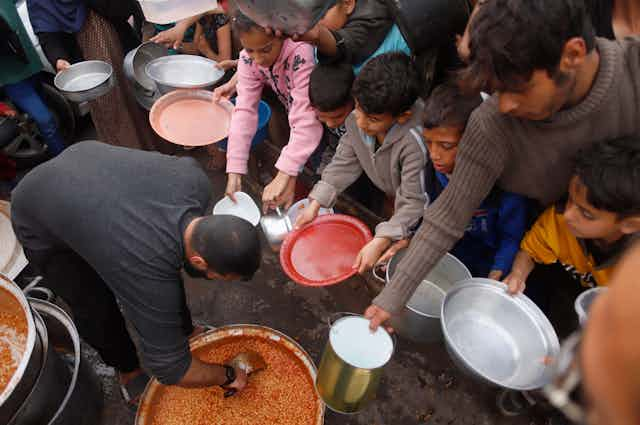Israel has banned the UN aid-coordinating agency, Unrwa, from accessing the population of northern Gaza where a major famine is now believed to be imminent. The country has accused UNWRA staff of involvement in the October 7 Hamas attack but has provided no evidence this was the case and the agency denies the allegations.
Across the whole 141-square-mile Palestinian enclave, there are now high levels of critical food insecurity. But the situation is worst in the governorates of North Gaza and Gaza, where the situation is assessed at the highest level under international standard IPC 5, which represents “catastrophe/famine”.
This is defined as “an area has at least 20% of households facing an extreme lack of food, at least 30% of children suffering from acute malnutrition, and two people for every 10,000 dying each day due to outright starvation or to the interaction of malnutrition and disease”.
The middle governorates of Deir al-Balah and Khan Younis, and Rafah in the south, are presently classed as being IPC 4, or “emergency”. This means the areas have large food consumption gaps, which are reflected in very high acute malnutrition and excess mortality.
Developing catastrophe
The Integrated Food Security Phase Classification or IPC was originally developed by the UN in 2004 for use in Somalia. It is administered and implemented by a global partnership of 15 organisations.
It enables both governmental and non-governmental organisations to assess situations using a scientific measure, allowing decision-makers to reach informed decisions quickly and accurately in situations of extreme urgency – as in Gaza at the moment.
According to the most recent IPC rankings published on March 18 and based on data taken during the month to March 15, 677,000 people in Gaza were in IPC 5 – that is, a “catastrophic” situation. Another 876,000 people were in IPC 4, or an “emergency”.
Some 578,000 people were judged to be in IPC 3 or “crisis” and 90,000 were in IPC 2 or “stressed”. There were no people in Gaza judged to be “food secure”.

But the situation is worsening by the day. By July the projections are that 1,107,000 people will face an IPC 5 catastrophe, another 854,000 people are expected to face an IPC 4 emergency and 265,000 people will be in an IPC 3 crisis.
In addition to the lack of access to sufficient food, the quality of the available food is also a major concern. There is a significant worry about “hidden hunger”. This is when, even when people have some access to food supplies, they are getting an insufficient quantity of essential nutrients.
The report goes into detail about the urgency of the nutrition situation in northern Gaza, where in January 2024 is was estimated that 98% of children consume two or fewer food groups, these being breast milk and eggs.
The report found that in the children they examined, legumes, vitamin A rich fruits and vegetables, other vegetables, grains, meat and dairy products, had “almost completely disappeared from their daily diet”.
It’s worth noting that 95% of pregnant and breastfeeding women had themselves consumed two or fewer food groups the previous day. Eating a well-balanced diet is crucial for pregnant and lactating women, as it directly impacts their health, the healthy growth and development of unborn babies and infants, postpartum recovery, and the quality of breast milk produced.
While most critical in northern Gaza, these conditions are repeated across the whole of the strip with varying severity.
Collapsing healthcare
The results of this lack of nutritious foods is increasingly manifest in a rise in preventable health problems, particularly among children. Given the breakdown in services across most of Gaza, the report said it had been unable to obtain sufficient information about the health of the population to “reach a minimum sample allowing exploitation of the information”.
Nonetheless the World Health Organization has reported steep rises in acute jaundice, acute respiratory infections, bloody diarrhoea, diarrhoea, meningitis and skin diseases. Attacks on hospitals and clinics, such as the sieges on Al-Amal and Nasser hospitals in the southern city of Khan Younis and the attack on Al-Shifa earlier in the month, will only exacerbate the situation.
Unwra’s commissioner-general, Philippe Lazzarini, called Israel’s closure of aid deliveries into northern Gaza “outrageous” and said it was an intentional plan to “obstruct lifesaving assistance during a man made famine”.
What can be done?
The IPC’s famine review committee (FRC) says a ceasefire is the only way to alleviate this imminent famine. Provision of food and medical aid must be scaled up as a matter of urgency.
Attacks on hospitals and sanitation facilities must be halted. And any humanitarian intervention must ensure that in addition to aid provision, commercial access to food and medicines must be restored as a matter of urgency.
It’s also vital that aid organisations be protected and allowed to collect up-to-date information about the state of the crisis, so that resources can be directed to where they are needed most. But there’s little sign of this happening at the moment.

